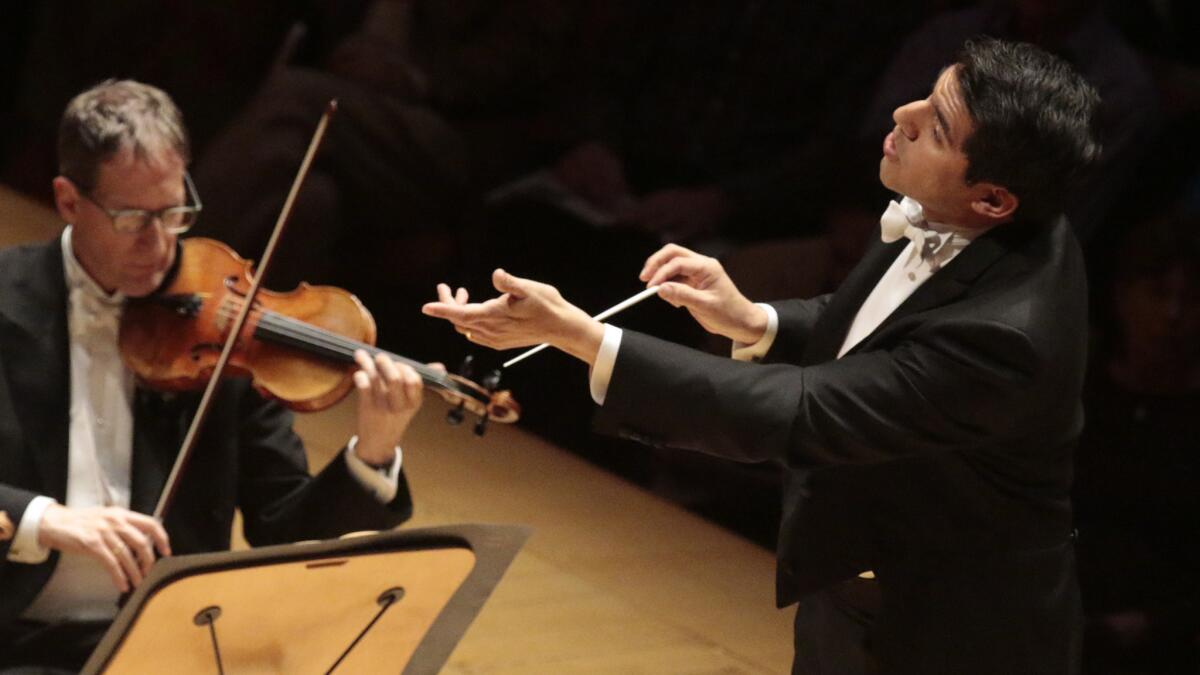Review: Miguel Harth Bedoya and L.A. Phil have special chemistry

Scientists have made a considerable effort to identify the characteristics of 103 elements, from hydrogen to lawrencium, and explain the complexities of their interactions. But better living through chemistry only goes so far.
The chemistry underlying an orchestra of 103 musicians remains a mystery. What makes a conductor and/or soloist jibe with a certain orchestra and/or audience goes far beyond our 21st century analytic powers.
On Thursday night, Miguel Harth-Bedoya returned to conduct the Los Angeles Philharmonic at Walt Disney Concert Hall. The young Peruvian conductor clicked immediately with the orchestra when Esa-Pekka Salonen appointed him assistant conductor in 1998 and promoted him to associate the next year.
In 2000, Harth-Bedoya became music director of the Fort Worth Symphony. Clearly he clicked in Texas too; he is still leading the orchestra.
Harth-Bedoya is hardly the same conductor he was when he first led a colorful performance of a suite from Prokofiev’s ballet, “Cinderella,” with the L.A. Phil in 2001. He returned to that suite Thursday for a program that repeats Friday and Saturday. This time the score was more vivid, more urgent and more commanding.
The musical effect might be likened to the difference between watching a VHS tape of the ballet on a 27-inch 2001-vintage television set and high-definition digital video on the latest large-screen, curved, 8K, OLED baby paraded at the Las Vegas Consumer Electronic Show. It was that dazzling.
The orchestra played as though it still thinks the world of Harth-Bedoya. And yet the audience response was surprisingly cool. I can’t explain why. Prokofiev may have something to do with it. This is a late score, composed in Russia during World War II, and it has never achieved a fraction of the popularity of Prokofiev’s earlier ballet, “Romeo and Juliet.”
But there are marvelous shadings of sentiment in “Cinderella,” and Harth-Bedoya was sensitive to them. In the duet at the ball between the Prince and Cinderella, a wistful woodwind phrase adds bittersweet seasoning to a tender melody. The accompaniment threatens to take on an enigmatic life of its own, and Harth-Bedoya made it bold, more moving than the main theme, as if to show that there are no simple emotions.
Harth-Bedoya conducted both the “Cinderella” suite and a punchy, exciting performance of Liszt’s “Mephisto Waltz No. 1,” which opened the program, from memory and with more intensity than I have heard from him. Yet he remains surprisingly on the fringes in the orchestra world.
He does not lack for key engagements in countries like Norway, Australia and Spain, and he has a considerable presence in South America. But whether orchestra chemistry or something else is involved, he does not get as many invitations from top U.S. orchestras as he deserves.
Emanuel Ax was the evening’s soloist in Chopin’s Second Piano Concerto. Ax beat the chemistry racket long ago, apparently loved everywhere he goes. He made his L.A. Phil debut as a 25-year-old 40 years ago, and the orchestra thinks of him as family. Tuesday night he appeared in a chamber music program with L.A. Phil members at Disney, as he often does when he’s in town.
Chopin’s concerto requires little help from chemistry. The orchestra is nearly superfluous, playing a minimally accompanimental role. Even so, this was an engaging performance not only because of Ax’s ability to convey the tactile beauty of Chopin’s piano writing but because the performance actually was a collaborative occasion. Ax spent much of the time at the keyboard facing the orchestra, catching the players’ eyes as though he were playing chamber music once more. Harth-Bedoya remained deferential to Ax, yet Ax seemed always ready to follow the conductor.
This really is chemistry in action because, in the end, the support was for Ax, whose playing was on the surface straightforward. He delivered Chopin as written, as if the elaborate figurations, the subtle rhythmic elaborations and all the rest were utterly natural, as though eloquence was the only option.
Ax has explored Chopin from many sides over the years, including recording concertos on period instruments. The chemistry behind his approach to the composer is seriously complex. But the Chopin that resulted Thursday was as uncontaminated and rewarding as water from a flowing spring. This the audience did like.
Twitter: @markswed
More to Read
The biggest entertainment stories
Get our big stories about Hollywood, film, television, music, arts, culture and more right in your inbox as soon as they publish.
You may occasionally receive promotional content from the Los Angeles Times.











